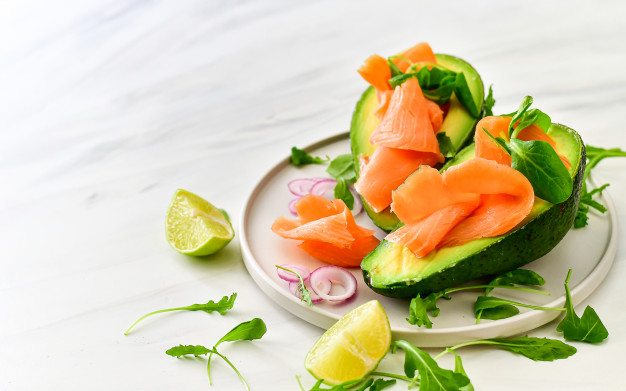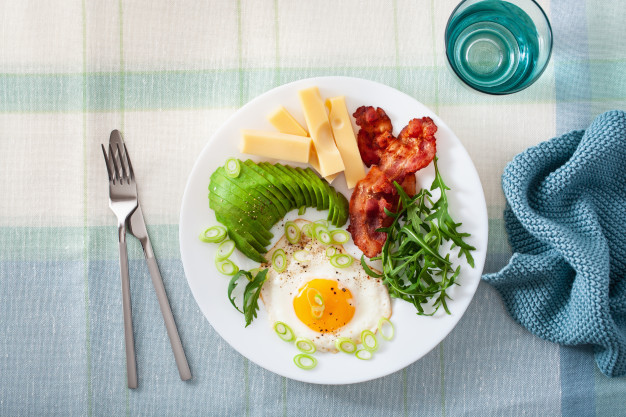
Easy Keto Meal Plan For Beginners

A ketogenic diet is very popular among athletes – including fitness and bodybuilders – because it helps shed fat tissue while maintaining optimal strength and recovery, and optimizing hunger pangs. Instead of carbohydrates and muscle glycogen, the body will use stored fat for energy – this is referred to as “ketosis” functioning. The duration of use of this diet varies from person to person because a prolonged absence of carbohydrate intake can slow down the metabolism and prevent the loss of fatty tissue. In this article, we’ll explain everything you need to know to make this type of diet a success.
The basics of the ketogenic diet
Traditional diets are all about lowering carbohydrate and fat intake, but the ketogenic diet works differently. It is a very low carbohydrate diet, offset by an increase in fat intake. Metabolized fat creates a state of nutritional ketosis where the body oxidizes stored fat and uses it for energy (hence the term ketogenic).
This diet is not new, it was developed after it was observed that fasting and ketosis sometimes make severe epilepsies go away, and has been used since 1921 in cancer control alongside therapies for certain medical conditions, and as a diet favored by athletes looking for better endurance or a way to lose weight naturally.
The ketogenic diet prescribes a massive reduction in carbohydrate intake and a significant intake of fat (70 to 90% of the total calorie intake), with fat becoming the primary source of body energy. When transformed into ketones, fats fuel the brain and provide energy to muscles. Besides losing fat tissue, this diet keeps you hungry and maintains strength and stamina, which is what makes it so popular.
This diet, however, must be followed with caution because, in the event that planning and monitoring is poorly done, it can cause:
-
Hypercholesterolemia (high cholesterol level) and hyperlipemia (high level of lipids in the blood)
-
Kidney stones
-
Dysmenorrhea (painful periods in women)
-
Osteoporosis (decrease in bone density, increased risk of fractures)
-
Diabetic ketoacidosis (due to the lack of insulin production, increased production of acetone bodies, which end up being wasted)
This diet requires the use of foods high in calories – and fat – such as butter, cream, coconut oil, olive oil, avocado oil, MCT type, avocados, salmon, mackerel… while foods containing carbohydrates are almost completely eliminated.

What to include for the ketogenic diet
Like every time you start a diet, you have to go through different steps and write everything down to be able to plan your progress. You have to take these measurements, weigh yourself and take the starting photos. Then comes the big question of the distribution of macronutrients.
-
It is necessary to calculate the basal metabolism as well as the calories necessary for your physical and daily activity.
-
Then you have to calculate your protein intake (Read more about high protein diets and the protein content of different foods).
-
The rest of the calories to be provided must be done as follows: at most, carbohydrate intake should not exceed 30 grams per day, and the rest should be provided in the form of lipids.
-
Do not forget green vegetables (green beans, salad, salsify, spinach, broccoli, etc.), because they provide fiber and slow down the absorption rate of food.
-
Of course, calorie intake should always be less than the amount consumed/used during the day, with a deficit of about 200-300 kcal / day for fat loss to be effective.
Here are the examples of foods that you can consume during this diet:
Protein
Without restriction:
-
Beef
-
Fish including fatty fish
-
Chicken (other than breasts)
Sometimes:
-
Bacon
-
Chicken or turkey breasts
-
Shrimp or prawns
Never:
-
Charcuterie with added sugar (read the label!)
-
Meat marinated in sweet sauces
-
Fish or chicken nuggets
Oils and fats
Without restriction:
-
Avocado oil
-
Olive oil
-
Coconut oil
-
Butter
-
Cream
Sometimes:
-
Sunflower oil
-
Safflower oil
-
Corn oil
Never:
-
Margarine
-
Artificial trans fats
Fruits and vegetables
Without restriction:
-
Avocado
-
Green leaves, such as spinach and arugula
-
Celery
-
Asparagus
Sometimes:
-
Leeks
-
Squash
-
Eggplant
Never:
-
Potatoes
-
Corn
-
Grapes
Nuts and seeds
Without restriction:
-
Nuts
-
Almonds
-
Flax seeds and chia seeds
Sometimes:
-
Unsweetened nut butters (almond or peanut butter)
-
Cashew nut
-
Pistachios
Never:
-
Mixtures of dried fruits
-
Nut or sweet seed butters
-
Nuts coated with chocolate
Dairy products
Without restriction:
-
Cheddar cheese
-
Blue cheese
-
Feta cheese
Sometimes:
-
Whole cottage cheese
-
Plain full-fat Greek yogurt
-
Whole ricotta cheese
Never:
-
Milk
-
Sweetened fat free yogurt
-
Ice cream
Sweeteners
Sometimes:
-
Stevia
-
Erythritol
-
Xylitol
Never:
-
Agave
-
Honey
-
Maple syrup
-
White and brown sugars
Condiments and Sauces
Without restriction:
-
Guacamole
-
Lemon butter sauce
-
Mayonnaise (no added sugar)
Sometimes:
-
Raw garlic
-
Tomato sauce (no added sugar)
-
Balsamic vinegar
Never:
-
Barbecue sauce
-
Ketchup
-
Honey mustard
Drinks
Without restriction:
-
Water
-
Almond milk
-
Bone broth
-
Plain tea
Sometimes:
-
Black coffee (watch your caffeine intake)
-
Unsweetened sparkling water (limit only if the bubbles make you swell)
-
Soda without sugars
-
Zero calorie drinks
Never:
-
Normal soda
-
Fruit juice
-
Lemonade
Herbs and Spices
Without restriction:
-
Salt (salt to taste)
-
Pepper
-
Thyme, oregano, paprika and Cayenne
Sometimes:
-
Grounded ginger
-
Garlic powder
-
Onion powder
Never:
-
Herbs and spices can generally be used in small amounts to add flavor to foods.
Supplements
It is advisable to take fiber and vitamins in addition to your diet.

7 Day Ketogenic Nutritional Plan
Here we’ll give you an example of a 7-day ketogenic diet, but remember to tailor it to your needs – after calculating how many calories your body needs, decrease calories by 200-300 kcal / day, then calculate the quantities of food needed.
60–70% of calories are from fat, 20–30% from protein and 5–10% from carbohydrates.
Day 1 – Monday
Total net carbohydrates: 20.7 g
-
Breakfast (4.6g net carbs): Scrambled eggs with sautéed onions and cheddar cheese
-
Snack (2g net carbs): Crunchy peanut butter caramel bar
-
Lunch (5.8g net carbs): 150g of ham, 2 cups of mixed greens with ½ avocado, 5 large black olives, ½ cup of sliced cucumbers and 2 tbsp. blue cheese vinaigrette
-
Snack (4.5g net carbs): 3/4 medium zucchini cut into sticks and 80 g of provolone
-
Dinner (3.8g net carbs): Baked catfish with broccoli and herb butter mix
Low carb diets have a diuretic effect, be sure to drink at least 6 to 8 glasses of water each day. Also, be sure to add extra salt to your diet to make sure you’re getting enough electrolytes.
Day 2 – Tuesday
Total net carbohydrates: 20.2 g
-
Breakfast (4.6g net carbs): Scrambled eggs with sautéed onions and cheddar cheese
-
Snack (4.4g net carbs): 1 cup sliced red pepper with 2 Tbsp. ranch dressing
-
Lunch (5.8g net carbs): Bacon and cheddar soup
-
Snack (2.2g net carbs): 1 stalk of celery with 2 tablespoons of cream cheese
-
Dinner (3.2g net carbs): Bone-in pork chop and 300 grams of cauliflower and cheddar puree
Day 3 – Wednesday
Total net carbohydrates: 19.7g
-
Breakfast (2.9g net carbs): Spinach and Swiss cheese omelet
-
Snack (1g net carbs): An Iso Whey Zero protein shake and Omega 3
-
Lunch (6g net carbs): Grilled chicken on baby spinach, tomato and avocado salad
-
Snack (2.2 g net carbohydrates): 80g of ham, 2 tablespoons of cream cheese and 2 wedges of dill pickles
-
Dinner (7.6 g net carbs): Sautéed beef with vegetables on romaine salad
Day 4 – Thursday
Total net carbohydrates: 19.3 g
-
Breakfast (4.7g net carbs): Cheese and spinach omelet topped with avocado and salsa
-
Snack (1g net carbs): An Iso Whey Zero protein shake and Omega 3
-
Lunch (6 g net carbs): Chicken tart with green salad
-
Snack (2.2g net carbohydrates): ½ medium zucchini cut into sticks and 40 grams of cheese of your choice
-
Dinner (5.4g of net carbohydrates): 250g hamburger garnished with 40g of pepper cheese, 1 small tomato, ½ avocado and 2 leaves of romaine lettuce
Day 5 – Friday
Total net carbohydrates: 21.9g
-
Breakfast (2.6g net carbs): 2 large eggs, ¼ cup grated cheddar cheese and 4 tbsp salsa cruda or pico de gallo
-
Snack (2g net carbs): An Iso Whey Zero protein shake and Omega 3
-
Lunch (6.9g net carbs): Chili Con Carne with 2 cups mixed greens and 2 Tbsp. Italian vinaigrette
-
Snack (4.4g net carbs): 1 cup sliced red pepper with 2 Tbsp. ranch dressing
-
Dinner (6g net carbs): Caesar salad without croutons
Day 6 – Saturday
Total net carbs: 20.7
-
Breakfast (4.9g net carbs): Red bell pepper filled with creamy eggs and spinach
-
Snack (1g net carbs): An Iso Whey Zero protein shake and Omega 3
-
Lunch (2.5g net carbs): Tuna salad with 170 grams of tuna, 2 stalks of celery, 1 spear of dill pickles, 2 tablespoons of mayonnaise
-
Snack (4.5g net carbs): 1 portobello mushroom, ¼ cup salsa cruda and 40 grams of pepper cheese
-
Dinner (7.8g net carbs): 200 grams of Italian sausage, ¼ medium onion, sliced and ½ red pepper, sliced with 2 cups of spinach, ½ cup of sliced mushrooms and 2 tbsp. blue cheese vinaigrette.
Day 7 – Sunday
Total net carbohydrates: 20.8 gr
-
Breakfast (2.9g net carbs): Pumpkin flaxseed Pancakes
-
Snack (1.7g net carbs): 5 whole snow peas and 80 g of cheddar cheese
-
Lunch (3.1g net carbs): 250 grams of chicken breast on 2 cups of Romain hearts – lettuce -, with 5 radishes and 2 tbsp. creamy Italian dressing
-
Snack (3.2g net carbs): 2 stalks of celery and 2 tbsp. cream cheese
-
Dinner (9.9g net carbs): Baked salmon with chermoula over broccoli
Once again, we hope you find this article useful and it helps you get started easily.